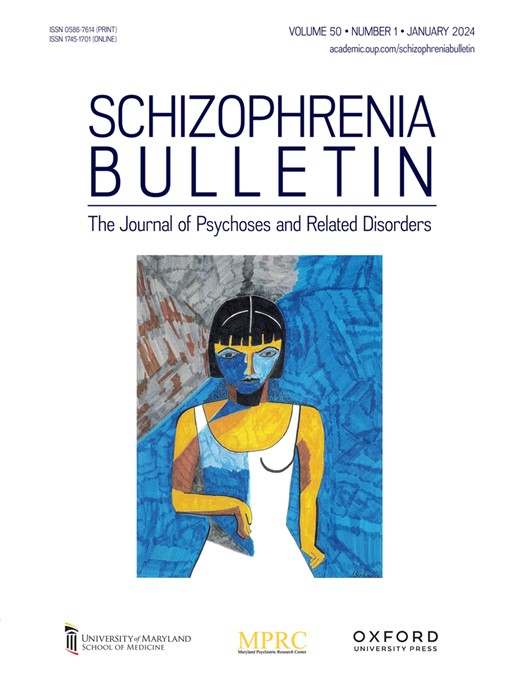Mental Health Professionals’ Perspectives on Digital Remote Monitoring in Services for People with Psychosis
IF 5.3
1区 医学
Q1 PSYCHIATRY
引用次数: 0
Abstract
Background and Hypothesis Digital remote monitoring (DRM) captures service users’ health-related data remotely using devices such as smartphones and wearables. Data can be analyzed using advanced statistical methods (eg, machine learning) and shared with clinicians to aid assessment of people with psychosis’ mental health, enabling timely intervention. Such methods show promise in detecting early signs of psychosis relapse. However, little is known about clinicians’ views on the use of DRM for psychosis. This study explores multi-disciplinary staff perspectives on using DRM in practice. Study Design Fifty-nine mental health professionals were interviewed about their views on DRM in psychosis care. Interviews were analyzed using reflexive thematic analysis. Study Results: Five overarching themes were developed, each with subthemes: (1) the perceived value of digital remote monitoring; (2) clinicians’ trust in digital remote monitoring (3 subthemes); (3) service user factors (2 subthemes); (4) the technology-service user-clinician interface (2 subthemes); and (5) organizational context (2 subthemes). Conclusions Participants saw the value of using DRM to detect early signs of relapse and to encourage service user self-reflection on symptoms. However, the accuracy of data collected, the impact of remote monitoring on therapeutic relationships, data privacy, and workload, responsibility and resource implications were key concerns. Policies and guidelines outlining clinicians’ roles in relation to DRM and comprehensive training on its use are essential to support its implementation in practice. Further evaluation regarding the impact of digital remote monitoring on service user outcomes, therapeutic relationships, clinical workflows, and service costs is needed.精神卫生专业人员对精神病患者数字远程监测服务的看法
数字远程监测(DRM)通过智能手机和可穿戴设备等设备远程捕获服务用户的健康相关数据。数据可以使用先进的统计方法(如机器学习)进行分析,并与临床医生共享,以帮助评估精神病患者的心理健康状况,从而实现及时干预。这些方法在检测精神病复发的早期迹象方面显示出希望。然而,关于临床医生对精神病使用DRM的看法知之甚少。本研究探讨了多学科员工在实践中使用DRM的观点。研究设计对59名精神卫生专业人员进行访谈,了解他们对精神病护理中DRM的看法。访谈采用反身性主题分析。研究结果:五个总体主题被开发出来,每个主题都有子主题:(1)数字远程监控的感知价值;(2)临床医生对数字远程监护的信任程度(3个子主题);(3)服务用户因素(2个子主题);(4)技术服务用户-临床界面(2个子主题);(5)组织背景(2个子主题)。结论:参与者看到了使用DRM检测早期复发迹象和鼓励服务用户对症状进行自我反思的价值。然而,收集数据的准确性、远程监控对治疗关系的影响、数据隐私、工作量、责任和资源影响是关键问题。政策和指南概述了临床医生在DRM方面的作用,并对其使用进行全面培训,这对于支持其在实践中的实施至关重要。需要进一步评估数字远程监测对服务使用者结果、治疗关系、临床工作流程和服务成本的影响。
本文章由计算机程序翻译,如有差异,请以英文原文为准。
求助全文
约1分钟内获得全文
求助全文
来源期刊

Schizophrenia Bulletin
医学-精神病学
CiteScore
11.40
自引率
6.10%
发文量
163
审稿时长
4-8 weeks
期刊介绍:
Schizophrenia Bulletin seeks to review recent developments and empirically based hypotheses regarding the etiology and treatment of schizophrenia. We view the field as broad and deep, and will publish new knowledge ranging from the molecular basis to social and cultural factors. We will give new emphasis to translational reports which simultaneously highlight basic neurobiological mechanisms and clinical manifestations. Some of the Bulletin content is invited as special features or manuscripts organized as a theme by special guest editors. Most pages of the Bulletin are devoted to unsolicited manuscripts of high quality that report original data or where we can provide a special venue for a major study or workshop report. Supplement issues are sometimes provided for manuscripts reporting from a recent conference.
 求助内容:
求助内容: 应助结果提醒方式:
应助结果提醒方式:


